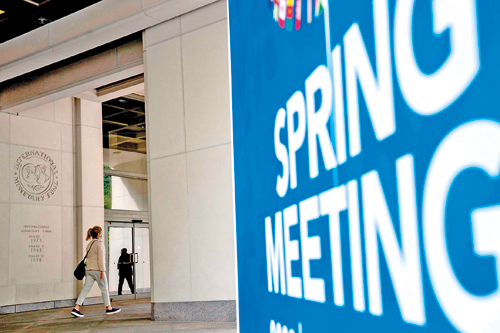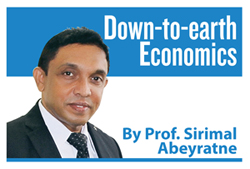Squeezing breath and default
View(s):
IMF headquarters preparing for the Spring meetings in Washington.
It was about a year ago, that many started talking about and sometimes asked me (this issue) as well: “What does it mean for a country to go bankrupt? What does it look like?” In fact, it was since mid-2018, that I (through this column) drew parallels from the bankrupt economies like Greece, Venezuela and Lebanon for Sri Lanka. Their journey towards bankruptcy took decades, but the fall was within a few years’ time.
Much earlier than that too, as far back as 2008, I noted Sri Lanka’s journey towards a “foreign exchange crisis”. In spite of all that, in 2009 as the war ended and IMF rescued us with its Standby Facility, our rulers started a real “gala time”.
We have even cooked our data to show that we were doing okay! Since 2005, we manipulated the “numerators and denominators” of macroeconomic indicators to show that our per capita GDP was growing, poverty was falling, and the budget deficit was under control. If you are not sure about what I said, let me elaborate the point I raised.
Questionable statistics
During a three-year period of 2010-2012, Sri Lanka reported 8 – 9 per cent rate of GDP growth – the highest rate of growth in three consecutive years in Sri Lankan history. It is a fact that, if the rate of growth is not accompanied by trade expansion and private investment, it would not be sustained. The higher rates of growth in the aftermath of the war was fed largely by the post-war construction and reconstruction activities of the government inflated by the growing public “debt bubble”. As a result, as anticipated, it did not last long!
Then, we boasted about the highest rate of per capita income growth, which was manipulated by the “nominal values” inflated by the price hikes under the appreciated exchange rate of the rupee. Per capita GDP in terms of US dollar terms gets inflated by a lower denominator, which is the rupee-dollar exchange rate, while the exchange rate should depreciate against inflation.
 During the period of 2000-2003, average rate of inflation was 9 per cent, while the exchange rate depreciation was 8 per cent, because the two should move closely; when the average rate of inflation hit 15 per cent during 2004-2008, exchange rate depreciation was 2.4 per cent only. The latter was the key factor which almost “doubled” the country’s per capita GDP figure in five years, pushing it above US$2,000 by 2008.
During the period of 2000-2003, average rate of inflation was 9 per cent, while the exchange rate depreciation was 8 per cent, because the two should move closely; when the average rate of inflation hit 15 per cent during 2004-2008, exchange rate depreciation was 2.4 per cent only. The latter was the key factor which almost “doubled” the country’s per capita GDP figure in five years, pushing it above US$2,000 by 2008.
It was in 2007, that Sri Lanka shifted from its “old method” of inflation calculation with the base year 1952 to a “new method” of calculation with the base year 2002. While the change had far-reaching statistical implications on the inflation statistics, it was not possible to identify the changes as the “old method” was abandoned immediately after the same year. The national poverty line is based on the average monthly expenditure of a household, calculated on the basis of the inflation rate.
The time period was also marked by an exorbitant increase in budget deficits, which appeared to be falling strangely as a percentage of GDP. For instance, the budget deficit in 2005 was reported as 8.7 per cent of GDP in the Central Bank’s Annual Report 2006, but for unknown reasons it fell down to 8.4 per cent in the Report 2007, and to 7 per cent in the Report 2009; in the same way, budget deficit in 2006 was 8 per cent of GDP as in the Report 2007. By implication, the current year budget deficit should decline correspondingly, showing a lower deficit than what it was!
Feeble cash flows
While the key statistics were playing their role in portraying a “rosy picture” of economic performance of the country, the internal and external finance positions of the country were not hidden but covered with borrowings. Internal finance is the government budget, while external finance is the foreign exchange flows.
It’s quite strange that at almost every consultation with the IMF recommendations for the achievement of sustainability in both internal and external finance positions were priorities. Most of the subsequent changes were guided more by political objectives than the economic objectives while the finance position continued to deteriorate.
In the case of internal finance, the country’s tax revenue as a percentage of GDP has declined significantly to around 10 – 12 per cent of GDP which should have been above 20 per cent; until now there is no proper income tax collection system. The tax revenue was not enough even to meet the annual loan repayment, while the entire public investment was based on further borrowings.
In the case of external finance, the most important stable foreign exchange earning should have been based on export growth, which has declined steadily from over 30 per cent to below 15 per cent in just 10 years from 2000-2010. As we often used to say – the growing trade deficit was cushioned by private remittances of the migrant workers and the natural increase in tourism after the war.
At a time that both the internal and external finance positions were in a critically weak status, the country made a big jump in its debt portfolio with commercial borrowings in 2007. As at present, 47 per cent of the country’s foreign debt account for the accumulated commercial borrowings.
Final episode – the default
As the country has been living beyond its means, the final straw began with the outbreak of the COVID-19 pandemic – the foreign exchange crisis. Just before the pandemic, Sri Lanka’s main foreign exchange inflows accounted for about $23 billion a year, including $12 billion worth exports. It was enough to cover just the country’s import requirement which was about $22 billion.
In addition, the country needed foreign debt repayment; this is now at over $5 billion a year mainly due to the maturing commercial borrowings. About 10 years ago foreign debt payment was around $1 billion. This means that Sri Lanka should borrow more in order to keep the external finance rolling every year!
It was in this context that the pandemic hit remittance flows and tourism income, putting external finance in an impossible position. Annual rolling strategy collapsed as, there was no way to find an additional $10-12 billion to meet annual imports plus maturing debt obligations. It was tried, hard for two years by cutting down imports, restricting foreign exchange payments, and seeking bilateral loans, credit lines and currency swaps.
At the end of the road, it was none other than defaulting foreign debt obligations, which was decided by the government this week. The short-term source of the problem was the utter waste of two years without any policy initiative to correct the mistake in the first place. Secondly, the tax cuts and then getting the Central Bank to finance government spending with unlimited money-printing and fueling the crisis by paralysing even production through import controls. Thirdly, the continuous denial of the gravity of the debt crisis.
However, the long-term source of the crisis was the aggravating internal and external finance. The political promise of “auctioning unavailable resources” to provide more and more handouts by the respective politicians has now come to an end, but with an unforgettable tragedy!
The road ahead
Foreign debt default does not mean at all a cancellation of debt, but rather a temporary suspension. With the forthcoming debt-restructuring attempts, hopefully with the IMF support, the due debts will be spread over a longer period of time making the debt payment little easier. But Sri Lanka will have to pay debt with accumulating interests as well.
However, the country has not yet escaped from bankruptcy! We are still there, anticipating much worse times ahead in the coming months. Inevitable default is only a sign of the fall.
The country will have to embark upon a credible reform programme in order to improve the internal and external finance position of the country. It would not be a comfortable policy regime for many, while not attractive to the politicians who are expected to play “third class” politics.
(The writer is a Professor of Economics at the University of Colombo and can be reached at sirimal@econ.cmb.ac.lk and follow on Twitter @SirimalAshoka).
Hitad.lk has you covered with quality used or brand new cars for sale that are budget friendly yet reliable! Now is the time to sell your old ride for something more attractive to today's modern automotive market demands. Browse through our selection of affordable options now on Hitad.lk before deciding on what will work best for you!


